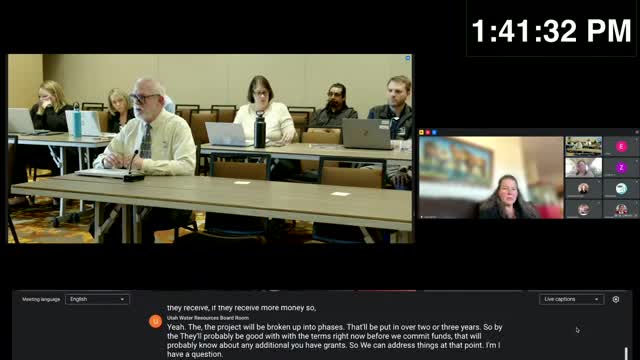Farmers to convert 100 acres to alfalfa with new irrigation system
March 22, 2025 | Natural Resources Department, Utah Environment, State Agencies, Organizations, Utah Executive Branch, Utah
This article was created by AI summarizing key points discussed. AI makes mistakes, so for full details and context, please refer to the video of the full meeting. Please report any errors so we can fix them. Report an error »

In a recent meeting held by the Utah Department of Natural Resources, discussions centered around the pressing issues of water management and agricultural productivity in the state. As the sun dipped low, casting a warm glow over the conference room, officials gathered to address the challenges posed by limited water resources and the potential for increased crop yields.
One of the key topics was the transition of approximately 100 acres of land from grass hay to alfalfa production. This shift is expected to enhance crop yields, particularly during the critical months when water availability is at its peak. However, the conversation revealed that the irrigation system currently struggles with inefficiencies, as many ditches are in disrepair, leading to significant water loss. The hope is that improvements to the system will allow farmers to access more water, thereby increasing their productivity during the growing season.
Tom, a participant in the meeting, highlighted the importance of this project, noting that while the water supply diminishes by July, the enhancements to the irrigation infrastructure could provide farmers with better access to water later in the season. This change is crucial for sustaining agricultural output in a region where water scarcity is a growing concern.
The meeting also touched on financial implications related to these agricultural changes. Shalane, another attendee, pointed out that while the expected benefits from increased crop production could lead to adjustments in payment structures, the focus remains on ensuring that farmers receive adequate support as they transition to more efficient practices.
As the discussions progressed, the board also reviewed a significant project involving the installation of a 15-mile pipeline and new water tanks in Perkin City. This initiative aims to improve water efficiency and reduce waste, a vital step in a region known for its pristine water sources. The project is expected to enhance the delivery of irrigation water, ultimately benefiting local farmers and the community.
As the meeting concluded, the urgency of addressing water resource management in Utah was clear. With ongoing projects and discussions, officials are working diligently to ensure that the state's agricultural sector can thrive despite the challenges posed by limited water availability. The path forward remains uncertain, but the commitment to improving water infrastructure and supporting farmers is a promising step toward a more sustainable future.
One of the key topics was the transition of approximately 100 acres of land from grass hay to alfalfa production. This shift is expected to enhance crop yields, particularly during the critical months when water availability is at its peak. However, the conversation revealed that the irrigation system currently struggles with inefficiencies, as many ditches are in disrepair, leading to significant water loss. The hope is that improvements to the system will allow farmers to access more water, thereby increasing their productivity during the growing season.
Tom, a participant in the meeting, highlighted the importance of this project, noting that while the water supply diminishes by July, the enhancements to the irrigation infrastructure could provide farmers with better access to water later in the season. This change is crucial for sustaining agricultural output in a region where water scarcity is a growing concern.
The meeting also touched on financial implications related to these agricultural changes. Shalane, another attendee, pointed out that while the expected benefits from increased crop production could lead to adjustments in payment structures, the focus remains on ensuring that farmers receive adequate support as they transition to more efficient practices.
As the discussions progressed, the board also reviewed a significant project involving the installation of a 15-mile pipeline and new water tanks in Perkin City. This initiative aims to improve water efficiency and reduce waste, a vital step in a region known for its pristine water sources. The project is expected to enhance the delivery of irrigation water, ultimately benefiting local farmers and the community.
As the meeting concluded, the urgency of addressing water resource management in Utah was clear. With ongoing projects and discussions, officials are working diligently to ensure that the state's agricultural sector can thrive despite the challenges posed by limited water availability. The path forward remains uncertain, but the commitment to improving water infrastructure and supporting farmers is a promising step toward a more sustainable future.
View full meeting
This article is based on a recent meeting—watch the full video and explore the complete transcript for deeper insights into the discussion.
View full meeting

